Season for knits
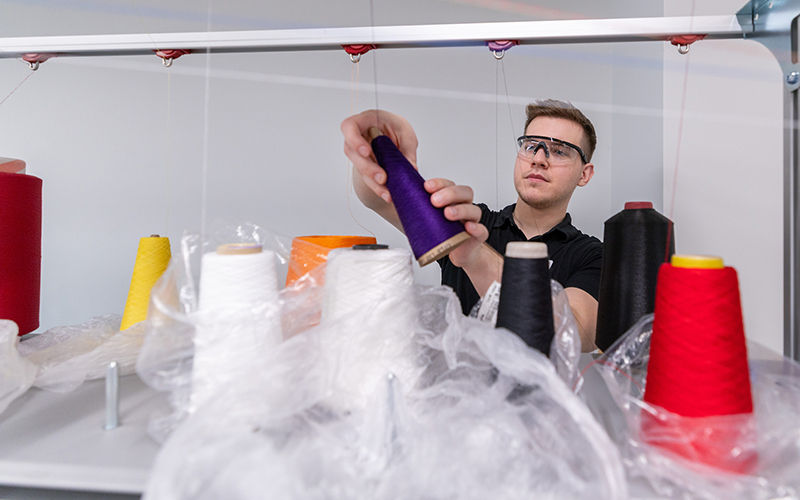
Photos by Christopher Gannon.
Shop supervisor Ethan Thomas sets up spools of thread on an industrial knitting machine Monday afternoon inside the Electronics, Textiles and 3D Printing Shop on the second floor of the Student Innovation Center. The shop is one of seven maker spaces in the student facility. Apparel merchandising and design students are working on knit color assignments in the lab this week. (below) Thomas discusses her knit project with AMD senior Kyla Birchem.
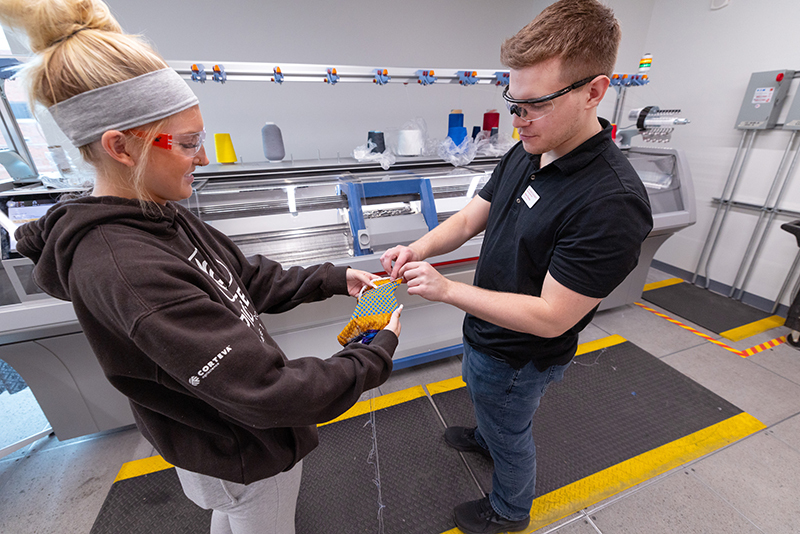
Regents approve plan to comply with DEI law
A report outlining how Iowa's regent universities will comply with Senate File 2435 was presented to the state Board of Regents at its Nov. 6-7 meeting in Cedar Falls. Signed into law in May, the legislation prohibits diversity, equity and inclusion offices at the regent universities as broadly defined by the law and with limited exceptions.
The majority of Iowa State units, programs, positions and spaces complied with the law or were otherwise exempt and may continue operating as they do now. However, the following changes are necessary to comply with the law:
- University programming associated with the Center for LGBTQIA+ Student Success will be discontinued. Student organizations, which are exempt from the legislation, may continue to offer programming and social activities in this area. The physical space in the Memorial Union will now be known simply as The Center and will remain open to all students and student groups free of charge.
- The annual Thomas L. Hill Iowa State Conference on Race and Ethnicity (ISCORE) will be renamed the Iowa State Conference on Research, Opportunity, Equality and Excellence in Education, and the scope of this event will be broadened to comply with the law. A committee of faculty, staff and students will be established to develop this conference.
- Three staff associated with these units will have their roles and responsibilities broadened to support student success for all students.
- Nine college staff who currently are in the multicultural student success job profile will have their positions reclassified into job profiles that more accurately reflect their roles and responsibilities to support student success for all students. The multicultural student success job profile will be discontinued.
- Any remaining DEI committees will undergo a review to ensure compliance with the law.
"While the law requires us to make adjustments, it does not alter Iowa State's long-standing commitment to have a welcoming campus," said President Wendy Wintersteen. "Since 1869, Iowa State has opened its doors to everyone with a desire to learn and work hard. We will comply with the law as we continue to support the educational success of all students and cultivate an environment where all members of the ISU community feel they belong."
The board has requested the regent universities complete most adjustments for compliance by Dec. 31.
A short FAQ
What programs and spaces were identified as exempt under the law?
Programs that were identified as exempt are listed in the board agenda on pages 80-81. At Iowa State University, the office of multicultural student affairs, including the Multicultural Center and the George A. Jackson Black Cultural Center; the Margaret Sloss Center for Women and Gender Equity and others do not function as a DEI office, and are not impacted by the law.
How does the law impact student organizations?
Student organizations are exempt from the law and may offer programming, activities or events as currently allowed by university policy.
How does the university support student organizations?
Faculty and staff serve as advisors to student organizations. Student engagement professionals in the division of student affairs provide resources and training for advisors and student organization members. Student Government takes requests for funding various activities proposed by student organizations.
Will students or other university community members be charged to use The Center's space?
No. There is no charge to reserve and use the space for activities.
Does the law impact coursework or research?
The law does not directly impact academic coursework or research.
Student success remains the priority
Student success programs are a priority and available for all students at Iowa State. The university is committed to providing a community where students can learn and grow while reaching their personal and academic goals. Information about leadership programs, learning communities and connection spaces are listed on the You Belong Here website.
Faculty and staff may serve as an advisor for a student organization. There are nearly 800 student organizations at Iowa State. Additionally, the Cyclone Support website connects students to mental health, safety and support resources on campus.
Faculty development assignments
In other Iowa State business, the board approved professional development (PDF) experiences during fiscal year 2026 for 43 faculty members from all six undergraduate colleges. Their plans include 19 assignments for fall semester 2025, 14 for spring semester 2026 and 10 for the 2025-26 academic year.
At Iowa State, all faculty members with at least halftime appointments are eligible to apply for a faculty professional development assignment. There isn't a length-of-service requirement, however priority is given to accomplished senior faculty, faculty who are seeking competitive fellowships such as a Fulbright Award, and those who haven't received a faculty professional development assignment in the past five years.
Is it time to look at a flex spending account?
The annual window for enrolling in employee benefit options opened Nov. 1 and closes at 5 p.m. Friday, Nov. 22. Benefit-eligible employees should remember:
- There's time to change your mind. Employees may tweak their selections as many times as they want up to the deadline; the last changes they submit before 5 p.m. Nov. 22 will be the final selections.
- In most instances, doing nothing means your current, 2024 plan year choices become the default for the new plan year, which begins Jan. 1. The exception is the two flexible spending accounts (FSA) for medical expenses or dependent care expenses. Employees must enroll in these plans every year they want to participate.
The 2025 open enrollment website, accessible from the benefits website, features many links and tools to help employees review and weigh their benefits options. These include:
- Slide show (PDF) on the components of the 2025 benefits plan.
- Instructions for reviewing your coverage and making changes.
- Plan summaries and premium levels.
- ALEX, an interactive tool that lets employees identify preferences and price out various health care scenarios. (Remember that actual enrollment occurs in Workday.)
- Information on contacting a benefits specialist.
Who can be on your plan?
Adding any of these eligible dependents to your health care or dental plan requires documentation confirming a:
- Legally married spouse
- Domestic partner
- Dependent child(ren) with a biological or legal relationship to the employee or enrolled spouse/ domestic partner and meets one of these criteria:
- Hasn't yet reached Dec. 31 in the year they turn age 26
- Unmarried, full-time student over age 26
- Living with a total and permanent disability
Two key pieces of the benefits package -- the health and dental plans -- are not changing for 2025. Employees may choose between Wellmark Blue Cross/Blue Shield HMO and PPO options for health care coverage, and between Delta Dental's basic and comprehensive plans. The comprehensive dental plan requires a three-year lock-in. As approved by the state Board of Regents earlier this fall, monthly premiums for health care and dental care will go up on Jan. 1.
Considering a flex spending account?
Each year, more than one-third of ISU employees enroll in a flexible spending account -- pre-tax dollars they set aside each month in an account to pay for out-of-pocket health expenses or dependent care expenses. ASIFlex administers these accounts, and the rules for each are slightly different.
The Internal Revenue Service recently announced 2025 limits for health care FSAs: $3,300 per employee, or $6,600 per household if each spouse or partner has an account. These funds can be used to pay for many out-of-pocket expenses, including medical and dental co-pays, eyewear, hearing aids and pharmacy (prescriptions and qualifying over the counter products). These funds can't be used for insurance premiums.
The good news is employees don't have to wait long to use these dollars for those reimbursable expenses. They have access to the entire amount they set for the year on the first day, Jan. 1. At the end of 2025, up to $660 unused dollars in this account can be rolled into the next year.
For help setting reasonably accurate contributions to an FSA, employees can use the "spend" report in their myWellmark portal, which will show them every dollar they've spent on medical expenses in 2024. They can do the same in their account on the Express Scripts website (pharmacy administrator in the ISU Plan).
For both the health care FSA and the dependent care assistance program (DCAP), the minimum contribution is $20 per month or $240 annually.
DCAP funds can help pay for care for children 12 years and younger, a disabled child or spouse, or a disabled parent living in the employee's home. The maximum annual contribution is $5,000 for a single person or married filing a joint tax return, and $2,500 for married individuals filing separate returns. Employees may only use DCAP dollars as they accumulate during the plan year, and end-of-plan-year rollovers aren't allowed for unused contributions.
Finally, any expenses covered by either flex account can't be claimed in a tax return.
Honors program introduces a second pathway to graduation
To better serve honors undergraduates whose post-baccalaureate goal is a job, not graduate school, the university honors program is launching a second pathway over the next few years. A key distinction is that in place of an individual, research-focused experience, honors students will work in interdisciplinary teams on a yearlong capstone project that focuses on one or more of the humanitarian challenges in the United Nations' 17 Sustainable Development Goals (SDG). These include poverty, gender equality, clean water, affordable clean energy, responsible consumption and quality education, for example.
The new innovation pathway also is more structured in its required seminars and supporting coursework, including honors sections of LD ST 3700 (Leadership, Entrepreneurship and Innovation) and ENGL 3020 (Business Communication).
Laurie Law, administrative director of the honors program, said the new pathway addresses both the skillsets employers say they want in college graduates and Gen Z's stated desire to make a difference.
"We're creating something that's project-management focused, truly interdisciplinary and focuses on career readiness," she said. "We received feedback from students who were struggling to find value in an honors program when they're not on a path to graduate school, which is what a lot of honors curriculums are built for. We need to keep evolving to meet their needs."
She said the more structured curriculum in years two and three gives students a foundation to spend a year on a capstone project.
"Our goal is that they're pitching their [capstone] solution at one of the innovation competitions already happening at Iowa State or off campus," Law said. "This won't be a requirement, but that's the level we're trying to get students to work at."
Opportunities for faculty
Law said several changes for the honors program are in the works to help support the two pathways. First, the faculty director post will be revived as a half-time or full-time position. The position has been vacant since 2018, when former Morrill Professor of English Susan Yaeger stepped down from the honors program.
Secondly, an honors program student fee would provide the funds to incentivize faculty invited to be part of honors seminars or capstones. The innovation pathway structure would include quarter-time faculty fellows, perhaps three each year, who provide academic coaching support to the capstone experience. With student team members, they'd also help identify faculty with relevant expertise who provide insight, on a short-term basis, to a team and its humanitarian challenge.
"We need additional dedicated faculty for the honors program, and we know we can't keep asking them to volunteer," Law said.
Third, a whole new series of honors seminars is being developed that focuses on sustainability and community activism, including an alternative spring break to Costa Rica. Law said she has invited nine faculty members to teach sections of the seminars for the first time this spring.
Rolling out the new pathway
This fall's first-year honors students were introduced to the two pathways, Law said, although the year 1 course requirements for both pathways are the same with themes of community, discovery and leadership. Beginning this spring, second-year honors students may choose the new innovation curriculum. This will continue for two academic years until the innovation pathway is fully implemented during the 2026-27 academic year.
By chance and driven by student initiative, the innovation team capstone concept is being piloted this year by 12 honors students who formed three project teams. Kurt Rosentrater, professor of agricultural and biosystems engineering, is the quarter-time faculty fellow advising the groups as they develop their challenges this fall. During spring semester, he'll help them find the additional faculty resources they need.
Law said the honors program draws a large number of students who are career-focused after their four years, so it's smart to help them develop skills they can take to their first job.
"High-impact practices like learning communities and undergraduate research started across the country as honors programming, but eventually weren't reserved just for honors students," Law noted. "So, what's the new cutting edge for honors programs? Where can we have impact? Honors programs inherently are interdisciplinary, so we think this pathway makes sense."
At a glance: Two Honors program pathways to graduation
|
Year |
Grad school accelerator |
Innovation |
|
1 |
HON 1210 (seminar), |
Same |
|
2 |
HON 3210 (seminar), contracted course |
HON 3220 (seminar), |
|
3 |
HON 3210 (seminar), contracted course |
HON 3220 (seminar), |
|
4 |
HON 4900 (ind study) |
HON 4900b (capstone, |
|
Credits (minimum) |
14 |
17 |
New Data Mart helps leaders crunch the numbers on enrollment
Implementing Workday Student as Iowa State's system of record not only transformed business processes for things like class registration and course offerings, it also altered how student data is categorized, stored and processed.
Since the enrollment management team released the official enrollment numbers in mid-September, Enrollment Research and Analytics (ERA), Institutional Research (IR) and IT Services (ITS) have been working to validate the data and create reports that present the full enrollment picture. The first of these detailed reports was published last week on the registrar's website, under "resources" in the "enrollment statistics" section.
Currently available data include enrollment numbers by headcount and FTE, by major or department, and by a variety of demographic variables. Institutional research also publishes enrollment reports as part of the university's online Fact Book.
Job one: Data accuracy
The fall 2024 reporting cycle has presented both challenges and opportunities in the transition from legacy systems to Workday. Greg Forbes, manager of data analytics in the ERA unit, said there are many differences between the two systems in how data is stored, which has required additional time and attention to produce various enrollment reports and make them available to the campus community.
"Data accuracy is of the utmost importance to ensure leaders have the information they need to make decisions for the university, or for their individual units," Forbes said. "Our teams have taken the time to redevelop every report in the new system, as we strive to provide reports that meet the changing data needs of campus."
Accessing the Data Mart
Previously, enrollment data in ADIN were captured and stored in a data warehouse and accessed through e-Data. During the transition to Workday Student, ERA, IR and ITS staff have been working with an external consultant, Phytorion, to replace e-Data with a new "Data Mart" that leverages Workday's enhanced capabilities.
"Our interdepartmental team has spent the past two years developing a reliable and valid database for official student reporting, integrating legacy data with Workday data and ensuring we can deliver accurate and reliable information," said Amanda DeGraff, IR associate director and Data Mart project director.
Like e-Data, Data Mart is snapshot data, which is particularly useful for numbers that don't change, for example in historical comparisons and trend analysis.
The fall 2024 enrollment reports on the registrar's site are the first of many reports that will be provided from the new Data Mart. The project team is engaged in a multi-year process to merge information from e-Data to the new Data Mart and provide reports on student retention, graduation rates and other student success measures.
"We appreciate everyone's patience as our teams work to provide the campus community with accurate and reliable data," explained IR executive director Karen Zunkel. "The plan for this year is that as data is validated, we will provide data and reports similar to what the campus community and public have been able to access in previous years. Report and dashboard development will continue to evolve in future years to meet campus data needs."
In addition to transitioning data from ADIN to Workday, the reporting teams concurrently are implementing Microsoft Power BI, a modern reporting and analytics tool for visually presenting Data Mart data. Kevin DeRoos, senior manager in ITS, said Power BI allows users to create dashboards that provide deeper insights into the data and better inform decision-making. Reporting teams will leverage this new tool to provide enrollment reports to campus. Later this academic year, enrollment management also will use the Power BI tool to replace theTableau dashboards shared with campus leaders.
Help still available
If a department or unit has a critical data need prior to that data being published (accreditation reporting requirements, for example), staff can send an email to studentdatarequest@iastate.edu.
P&S staff are top users of Adventure2
Stephanie Downs, senior coordinator for ISU wellbeing and worklife, updated the Professional and Scientific (P&S) Council on participation in the Adventure2 program during the group's Nov. 7 meeting. Adventure2, now in its eighth year, provides resources and activities designed to help employees with their physical and mental well-being.
Registration in the program has grown from just under 2,000 employees in its first year to nearly 3,500 by the close of last year. More employees have registered for the program and taken the well-being assessment this year than a year ago, she said.
"The well-being assessment is important because it allows us to see where we are strong in the offerings we provide and where there are needs," Downs said.
Seventy-two percent of P&S staff registered for Adventure2 this year with merit employees second at 57%. Thirty percent of P&S staff have completed the well-being assessment and 35% have participated in an activity.
Proposed bylaw changes
In other business, council president Jason Follett introduced proposed changes to the council's rules and bylaws on behalf of the executive committee. Generally, the changes would better align the council's committee structure with the current needs of P&S employees and use councilors' time more efficiently. In recent year, council leaders have struggled to keep council seats filled. Councilors will vote on the proposals at the December meeting. As proposed, the changes would:
- Return three vice president positions (compensation and benefits, communication and community relations, and diversity, equity and inclusion -- DEI), to committee chair status. Several years ago, the council elevated three committee chair positions to VP with the intent of alleviating university demands on the council president's time and creating areas of expertise for those vice presidents.
- Merge two committees (DEI, peer advocacy and policy) to form the community relations and advocacy committee. This also centralizes the council's communications function again, rather than delegating it to each committee. The change results in six standing committees instead of seven.
- Standardize councilors' term length at three years. This eliminates one- and two-year terms designed to assure that about one-third of council seats were up for election each year.
- Simplify the process for filling vacated council seats for the remainder of a fiscal year. Instead of a nomination and vote process at a council meeting, the council president would make the appointment, which takes effect as soon as the appointee accepts. The governance committee would continue to be the group that maintains a roster of eligible nominees based on the council's most recent election results.
Three former students to be honored at Gold Star Hall ceremony
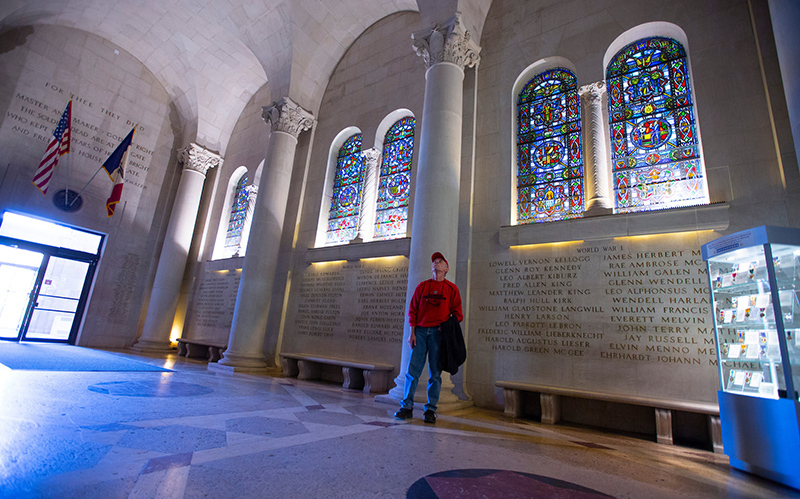
Gold Star Hall just inside the Memorial Union north entrance. File photo by Christopher Gannon.
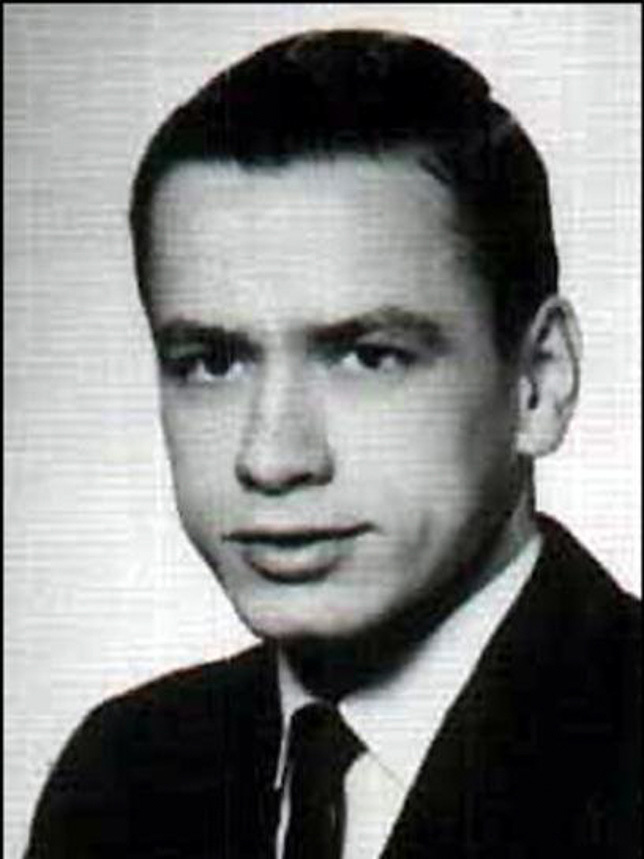
Herrick Jr.
James Herrick Jr. was on a reconnaissance mission over Laos in 1969 when the plane he was piloting was lost near the North Vietnam border, and he was never seen again. Six years later, the Iowa State University graduate was declared killed in action.
Herrick is one of three former Iowa State students who will have their stories shared during the annual Gold Star Hall Ceremony on Wednesday, Nov. 13 (4:15 p.m., MU Great Hall).
The Gold Star Hall Ceremony, which was started in 2003, is a way to remember and honor Iowa State students who died while serving their country. The names of these students are inscribed on the walls of Gold Star Hall inside the north entrance of the Memorial Union. Each year, the ceremony committee selects a group of students to recognize with narratives about their lives before the war and their experiences during the war.

Peterson
This year's honorees are (click on each link to read their story):
- Army 1st Lt. Sidney Peterson, who served in World War II and died after taking on anti-aircraft fire aboard a B-26 Marauder.
- Air Force 2nd Lt. Max Harvey Collins, who died when his aircraft crashed on takeoff during the Korean War.
- Air Force Capt. James Wayne Herrick Jr., whose plane was lost near the North Vietnam border during a reconnaissance flight.
President Wendy Wintersteen, Memorial Union director Chad Garland, ISU student veteran Brandon Culwell, and chair and professor of military science Army Lt. Col. Frank Sperl will speak during the ceremony. There will be performances by an ISU student string quartet, ROTC Air Force Cadet Choir and an Iowa Army National Guard Band bugler.
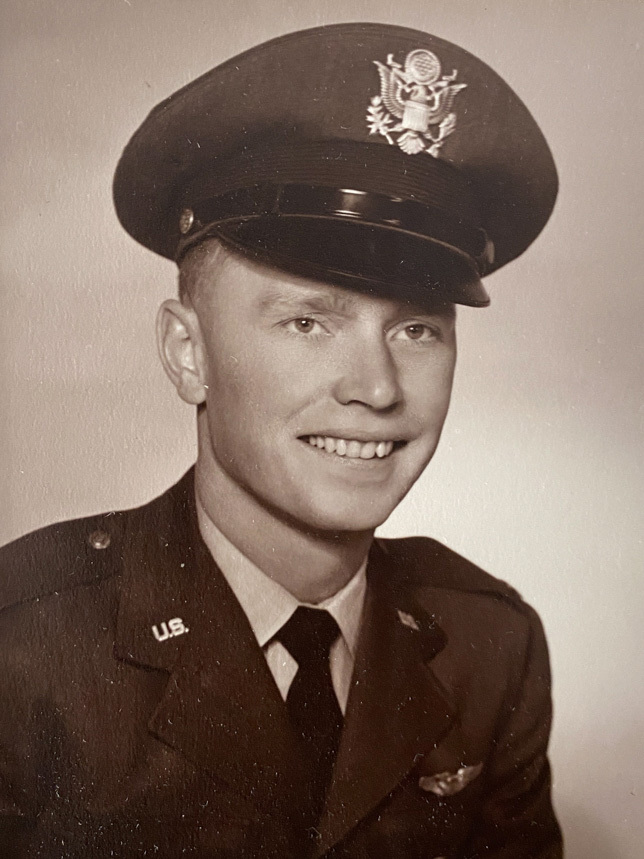
Collins
The men's personal narratives will be read by three military veterans.
The Memorial Union was built in 1928 to honor Iowa Staters who died in World War I. It continued to be a living memorial for students who died in future conflicts. Additional names have been added to the walls of Gold Star Hall throughout the years.
